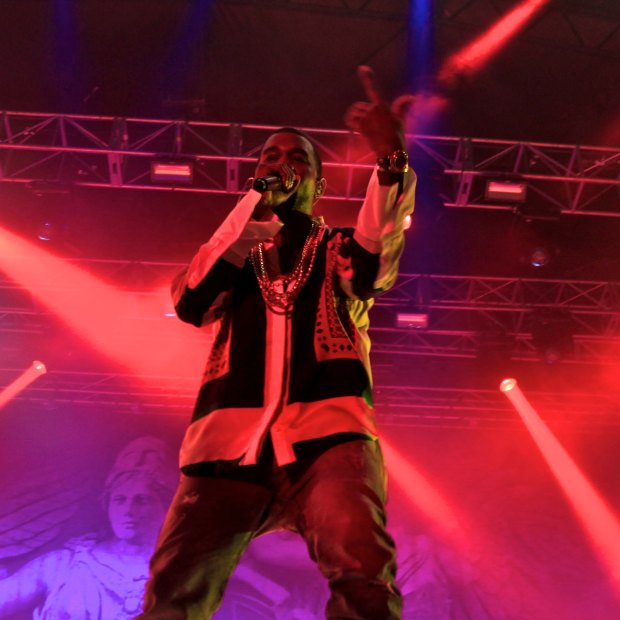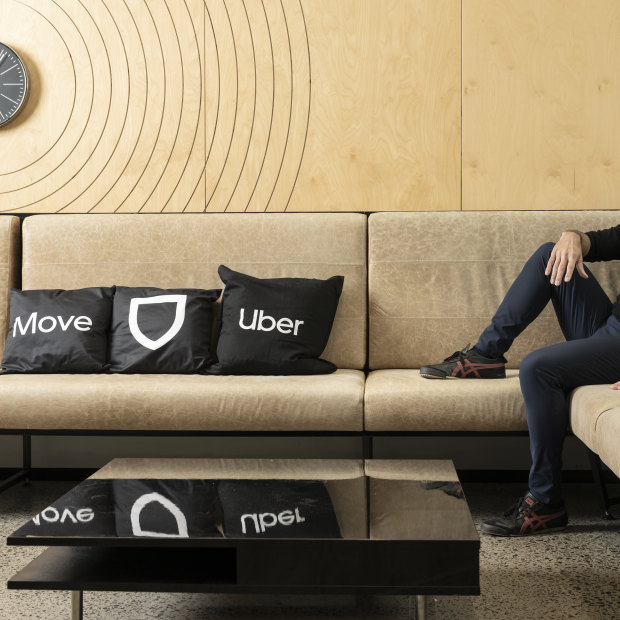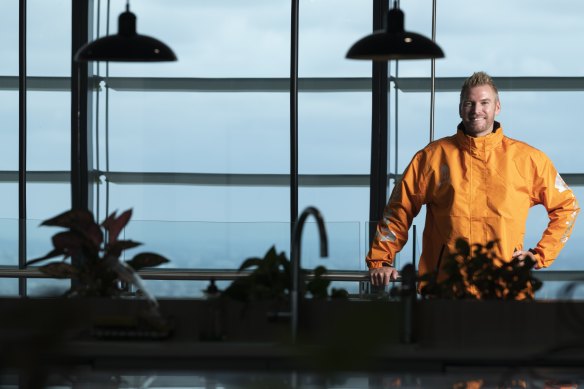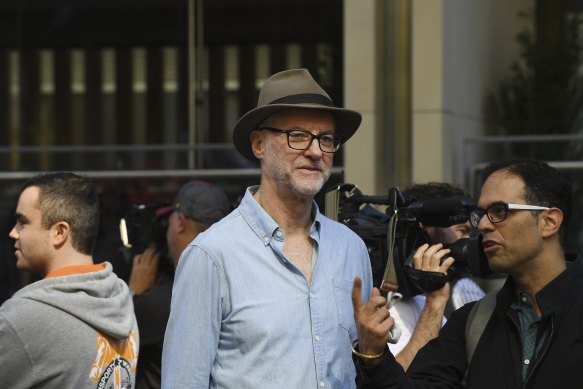
By Nick Bonyhady and Jessica Yun
At an Uber Australia event in September celebrating 10 years of dominance since the transport giant first arrived in Australia, the artist formerly known as Kanye West’s song Power pounded through the speakers on between speeches from the company’s bosses. “At the end of the day, goddammit, I’m killin’ this s–t, I know damn well y’all feeling this s–t”, the 2010 hit goes. There was a boat party too and pop duo Peking Duck, known for smash hits High and Wasted, performed.
Kanye West performing in Sydney in 2012 in the era he produced the Uber favourite Power. Credit:Edwina Pickles
As the Uber staff partied, their rivals at Deliveroo were unknowingly on their last legs. About two months later on November 16 they had their own gathering, trooping to a local Melbourne pub to commiserate about being laid off en masse as the company abruptly pulled out of Australia. Some had been in tears. There were signs in the days before that something was amiss. Staff had been told to submit expenses early and project approvals were being delayed. A source familiar with its finances said Deliveroo had fallen behind on office rent in their final months to the tune of $71,280. But few could have predicted what would come next.
“I was expecting something, I was expecting lay-offs,” said one former staff member, speaking on condition of anonymity to protect future job prospects. “And then on Wednesday… we had an all-hands meeting at 3pm and the CEO got up and said, ‘G’day guys, we’re closing in Australia’.”
The news went out just after and the machinery of winding down a company got to work. Staff were treated well, the former staffer said. Entitlements will be paid, staff were told, and laptops could be kept. Career support was offered.
Deliveroo was the oldest purely gig economy food delivery company in Australia. Since it launched in 2015, it had grown to employ about 150 head office staff in areas such as operations and marketing and was a key source of income for 14,000 contracted riders delivering countless meals to hungry consumers across the country.
But its stint in Australia was controversial. Deliveroo popularised a category of business that has vastly expanded the pool of independent contractors in Australia, workers who do not get guaranteed minimum wages and conditions like full-time employees, and crucially, lack workers compensation for injuries or worse. In 2020, five riders died in three months, drawing attention to the risks of the work on bustling city streets.
Food delivery apps surged in popularity during the pandemic when consumers were locked at home and couldn’t visit restaurants. Despite this popularity, few operators were able to make sustainable profits. The industry had surged into view with low or no delivery fees, making it hard for consumers and restaurants to resist signing up. That was fine when interest rates were at rock-bottom levels and investors were willing to fund losses.
Now, lockdowns are a thing of the past, interest rates are rising, new regulation is coming and not only Deliveroo is feeling the pinch. A string of other services have either shut up shop (Voly, Quicko), are cutting jobs (Menulog) or facing serious questions about their future (Milkrun).
There is one clear exception. As the food home delivery industry consolidates, it appears that, despite West’s warning that “no one man should have all that power”, there will be one truly dominant service left standing: Uber.
Uber global chief executive Dara Khosrowshahi visited Australia briefly in October to thank his staff for a turbulent, but dominant, decade.Credit:Louie Douvis
Uber ascendant
Financial documents lodged with the corporate regulator give a glimpse, but not a comprehensive picture, of the scale of Uber’s Australian business, which one industry insider said was a “jewel in the crown” of its global operation. Australians appear to have spent $7.3 billion on Uber’s platforms last year, based on an interpretation of its accounts by the Centre for International Corporate Tax Accountability and Research (CICTAR), an activist think tank. Most of that goes to the couriers, drivers and restaurants, but it took $2 billion in customer contract revenue, which includes the fees it charges. It made $1 billion in gross profit, a measure of income after deducting the direct costs of its services.
‘What became really clear from the beginning is they had a lot of money and they were prepared to lose it. And it was unlimited.’
Uber spent $172 million on marketing last year, and has some of the country’s best-loved and most-expensive figures in its ads, including tennis star Ash Barty and the late Steve Irwin’s family, along with international stars such as Kim Kardashian. There was also $936 million in oblique “administration” costs, and its financial arrangements have sparked claims from CICTAR and several unions worldwide, that Uber uses a Dutch tax minimisation strategy. Its Australian 2021 profit after income tax was $9 million.
Whatever the true dollar value of Uber’s success, which is across its initial ride-sharing business that launched in 2012 and the Uber Eats division that began in Australia in 2016, it is much more than its competitors. Its marketing budget alone is more than many of its rivals’ annual Australian revenue in recent years.
In 2020, the most recent year for which Deliveroo’s financials are available, it generated about $117 million in fee revenue and a $7.8 million profit after income tax. DoorDash pulled in about $53 million that year. Menulog’s finances are not available from the corporate regulator, suggesting it does not meet the threshold for being a “large proprietary company”, which includes $50 million in annual revenue.
Uber’s revenue, by contrast, was $1 billion (lower than in 2021 due to a change in the way it reports its earnings.)
None of these companies directly answered questions about their Australian financials.
‘It’s the US giants that dominate’
A decade ago, Labor Senator Tony Sheldon was the national secretary of the Transport Workers’ Union, which has been perhaps Uber’s chief antagonist in the years since.
“What became really clear from the beginning is they had a lot of money and they were prepared to lose it,” Sheldon says. “And it was unlimited.”
In Sheldon’s eyes, these investors were making a long-term bet, losing money hand over fist in the early days to capture a market and rake in returns when Uber grew large enough (or cut labour costs sharply enough whenever self-driving cars become a reality).
Which is what now appears to be happening.
Uber has claimed about 50 per cent to 60 per cent of the Australian market, according to figures by delivery management software Deliverect. Coming in second place with roughly 25 per cent market share is DoorDash, followed by Menulog at 20 per cent. Deliveroo held around 8 per cent of the market before it pulled the pin.
“I see a further concentration,” says technology regulation expert and UNSW associate professor Rob Nicholls, likening the situation to Coles and Woolworths’ dominance of the supermarket industry. “It’s the US giants that dominate.”
University of Sydney employment relations expert Dr Alex Veen says Deliveroo’s Australia exit has been on the cards ever since the company announced months ago it was leaving Spain and the Netherlands to focus on stronger areas. Since going public in the UK in March 2021, Deliveroo has been accountable to a market that increasingly values profitability.
He also sees some strategic missteps, including a focus on higher-end restaurants. Meanwhile, Uber leveraged its existing rider and driver base to add grocery delivery to its services, capitalised on its first-mover advantage to build a strong brand, and has slick apps. It got ahead of job cuts by laying off thousands in 2020 and has rebuilt from a period of shaky performance in the pandemic as more migrants enter countries such as Australia post-pandemic. Delivery fees have risen and the discounts and vouchers that lured customers to the platform in its early days are drying up, aiding profitability.
Late entrant DoorDash has diversified revenue streams through last-mile and white-label delivery services and now grocery delivery from company-owned corner stores as well.
“In order for the business model to work, they need economies of scale,” Veen says. In other words, if a platform doesn’t have enough riders to get food to customers fast and enough restaurants to delight a wide array of palates, customers will go elsewhere, order volumes will fall and a platform can enter a death spiral.
Yet while Uber appears to have seen off some high-profile competitors such as Deliveroo and Menulog, it will not have the food delivery market entirely to itself.
DoorDash’s revenue grew 300 per cent from 2020 to 2021, hitting almost $160 million with little fanfare, according to filings with ASIC. And it has pursued high-profile sponsorships of sporting events from the NRL to esports tournaments for the wildly popular computer game League of Legends.
Local players come and go
Meanwhile, rising interest rates and concern about consumer confidence – which have battered the share price of the major gig economy players – mean the funding environment for high-risk, high-reward, loss-making start-ups has sharply turned too.
“There’s going to be a limit to how patient [venture] capital is going to be,” says Nicholls.
A cohort of Australian-owned rapid-delivery start-ups such as Voly and Milkrun, which made splashy debuts in the last two years, were determined to differentiate themselves from their gig economy predecessors. They leased their own warehouses to stock groceries and employed their riders with full benefits and sometimes above-market pay rates to deliver food.
But they appear to have overestimated how long the tailwind of pandemic lockdowns would last: as people enjoy travelling and dining out once more and the cost of living increases, the need for these services has faded.
“Overpriced chips delivered in 15 minutes is going to be a harder proposition when everybody’s belt tightening,” Nicholls said. “I don’t see them expanding beyond that high-density living, and I think that there’s going to be a problem actually with that whole business model.”
In his first interview as Voly administrator after being called into the failed firm last week, John Vouris from accountancy firm Hall Chadwick said his team was working out the money owing and number of creditors Voly had left behind.
Vouris’ first priority is to quickly see if anyone wants to buy what remains of the business, which has no staff.
All that remains of Voly is its name, some intellectual property, 10 store sites, two offices and some stock. “Obviously food is perishable but alcohol is not,” Vouris says.
Labor in a fighting mood
At a speech to a union function in August, Workplace Relations Minister Tony Burke was in a fighting mood. Gig economy work, he declared, was “spreading like a cancer” through the economy and driving down wages. Labor would introduce new laws, expected next year, to let an independent umpire give employee-like workers employee-like rights, such as a minimum wage.
Uber and other firms have fiercely disputed that they suppress wages. It has said its drivers earn $38 an hour, for instance and championed the flexibility and efficiency that gig economy work offers. And all the major gig players have come around to support some sort of reform in principle.
But the threat in regulation is clear. Foodora, another early gig economy food delivery player, left Australia amid lawsuits that ultimately found it was employing its riders. Dr Greig Taylor, an expert in the on-demand gig economy and industrial relations and UNSW lecturer, sees parallels. “They basically predicated their estimates of revenue and profits for the people who bought into them on keeping [riders] as self-employed contractors because obviously the labour costs immediately skyrocket as soon as they’re categorised as employees.”
“I can’t do much about what Uber did before I was here, but I do think that what I can do is make sure that we’re growing the right way now.”
On a flying visit to Australia in October to hail a decade in Australia, Uber’s global chief executive, Dara Khosrowshahi, emphasised his company’s newfound determination to work with governments on regulation. It signed a pact with the Transport Workers’ Union in June, committing it to supporting minimum standards in the industry.
Since starting at the company in 2017, Khosrowshahi has consistently tried to distance himself from the tenure of pugilistic founding chief executive Travis Kalanick but kept the basic gig economy model intact. Asked on that October trip about Uber’s brash entrance into Australia, where it upended the taxi industry and moved quickly to win customers and political influence, Khosrowshahi preferred to talk about the future.
“I can’t do much about what Uber did before I was here, but I do think that what I can do is make sure that we’re growing the right way now…. What I brought was a culture change… it’s an important service in people’s lives. It’s an important service for earners. And ultimately, we have to work with regulators versus against them in order for this business to thrive.”
Under local managing director Morten Belling, Menulog became the first gig economy food company to trial employing couriers. It has suffered setbacks but the company is hopeful fresh pay rules could unlock better conditions while retaining flexibility, if implemented carefully.Credit:Rhett Wyman
But the tension is in the details, and Khosrowshahi would not commit to supporting Uber drivers being given identical workers’ compensation to Australians who are in traditional employment.
“I think as a principle matter, it depends, right?” he said of the compensation question. “It’s as if there are two different circumstances, so I can’t be prescriptive as to which one should be the case.”
For this story, Uber refused to answer detailed questions about its financials, internal events, and reasons for its success. Instead, a spokesman sent a general written statement saying it was deeply committed to the delivery people and businesses who use its app and wanted to keep increasing their earnings.
“Independent work plays an important role in our communities and economy, and we’re committed to improving standards for all gig workers, no matter what platform they use,” the spokesman said. “We want to continue working with the government to protect access to flexible work while ensuring Australia remains an attractive place for businesses to innovate and invest.”
Deliveroo would not answer questions about its earnings on the record. In its statement on November 16 announcing its exit from Australia, the company said it could not reach a sustainable and profitable scale without huge investment, which would not meet the company’s capital allocation standards.
“This was a difficult decision and not one we have taken lightly,” said Eric French, its chief operating officer.
A Menulog spokesperson said its 16-year history had allowed it to reach of 93 per cent of the population. “We have the scale to maintain a strong position in the market, and scale is essential to success in such a competitive, low-margin market,” the spokeswoman said.
However, it suggested it would not enter the rapid grocery sector due to existing competition. “We are taking a considered approach to instant grocery market services with our priority set on profitability and sustainability.”
The company said it was pleased that Workplace Relations Minister Tony Burke was consulting with the on-demand industry, but emphasised the importance of retaining flexibility. It is the only major gig economy food delivery company to be trialling employing its couriers directly.
“We cannot stress enough the importance of the federal government’s consultation process including extensive engagement with the contract courier workforce, the very group they are seeking to assist. There is currently a level of concern amongst couriers that they are going to have restrictive conditions thrust upon them which will impact their ability to make a living.”
A DoorDash spokeswoman said the company had agreed upon a statement of principles with the Transport Workers’ Union in May that committed it to supporting workers’ rights and entitlements and a dispute resolution processes.
“We were the first platform to push for this change and are pleased to see others in the industry make similar commitments since,” the spokeswoman said.
“We look forward to making a constructive contribution to the government’s policy consultation and are optimistic there is a path to reform that strikes the right balance for workers, and for this important industry.”
For his part, Sheldon is sanguine about the industry’s new approach.
Labor senator Tony Sheldon, an influential factional player in the party and long-time unionist, has been one of Uber’s primary adversaries in Australia. He gives cautious credit to its newly collaborative approach.Credit:Kate Geraghty
“It might sound very strange from someone who’s been highly critical of Uber [Sheldon has previously labelled Uber a “criminal outfit”] but I’ll give them credit for where they’re at now,” Sheldon says. “And I’ll reserve credit for the future.”
The Business Briefing newsletter delivers major stories, exclusive coverage and expert opinion. Sign up to get it every weekday morning.
Most Viewed in Technology
Source: Read Full Article



